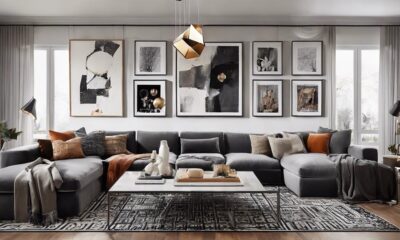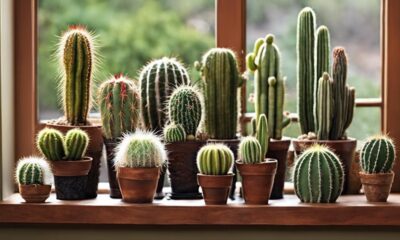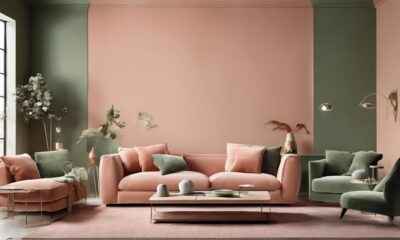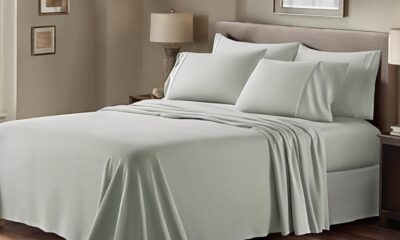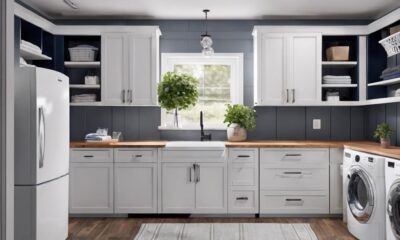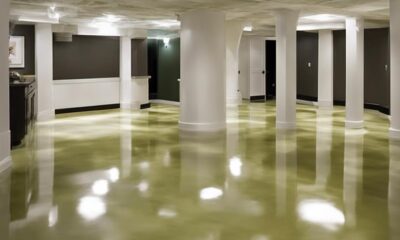Decor
What Can I Make a Vase Out Of?
2025
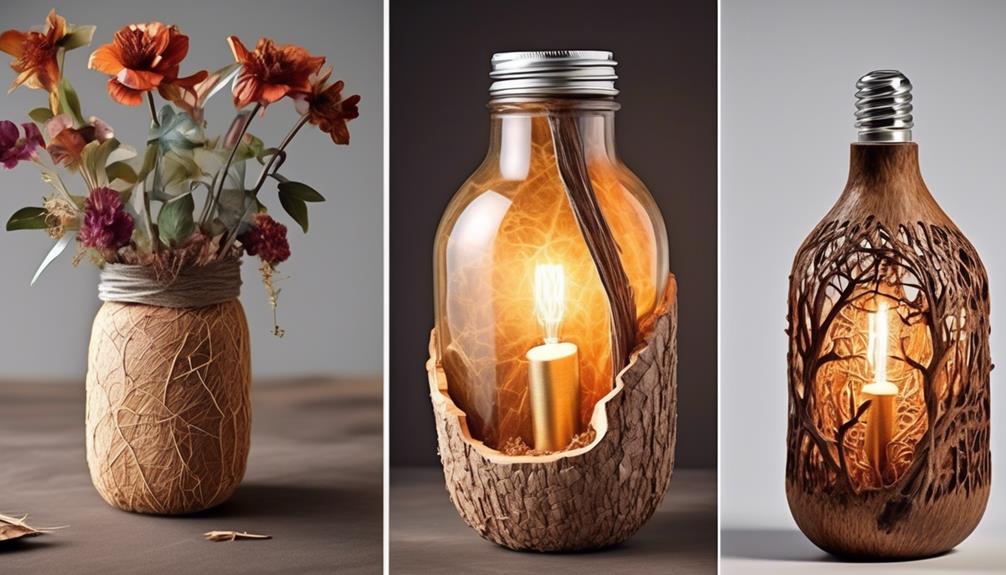
When we contemplate a vase, it frequently emerges in our minds as an emblem of grace and beauty, cradling vivid flowers or rich foliage.
But have you ever considered the multitude of materials that can be used to create a stunning vase? From the traditional glass and ceramics to the more unconventional objects, the possibilities are endless.
Whether you're looking to add a personal touch to your home decor or embark on a creative project, exploring the diverse options for crafting a vase can be both inspiring and practical.
Key Takeaways
- Glass blowing and pottery techniques are traditional methods used to create vases, requiring patience and precision.
- Natural and organic materials such as driftwood, bamboo, and fruit peels can be used to craft vases, adding earthy textures and sustainability to living spaces.
- Upcycling and recycling discarded objects like glass bottles and plastic bags offer a sustainable approach to creating unique and stylish vases.
- Polymer clay and resin provide endless design possibilities for creating intricate and durable vases with vibrant colors and textures.
Glass and Ceramics
Let's explore the art of crafting glass and ceramics, where we fuse creativity with practicality to create beautiful and functional pieces.
Glass blowing is a mesmerizing craft that involves shaping molten glass into various forms using a blowpipe, molds, and tools. The intense heat and precision required make it an exhilarating yet delicate process. The skillful hands of artisans bring forth stunning vases, bowls, and sculptures, each with its own unique character and charm.
On the other hand, pottery techniques offer a different avenue for creating vases. From hand-building to wheel-throwing, the possibilities are endless. Hand-building allows for more organic and freeform designs, while wheel-throwing demands finesse and control. The tactile nature of working with clay provides a deeply personal connection to the finished piece. Through techniques like coiling, pinching, and slab construction, vases can take on diverse shapes and textures, reflecting the artist's imagination.
Both glass blowing and pottery techniques require patience, precision, and a deep understanding of the materials. The melding of artistry and functionality in crafting glass and ceramics yields pieces that enrich our lives with their beauty and utility.
Natural and Organic Materials
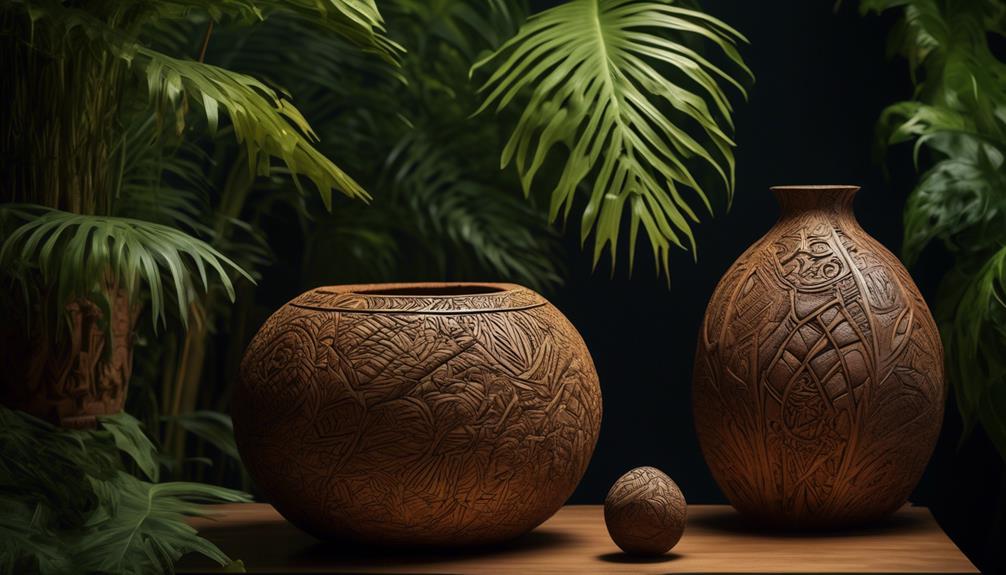
Crafting vases from natural and organic materials invites a harmonious blend of earthy textures and sustainable aesthetics into our artistic endeavors. When working with wood and plant-based materials, there's a sense of connection to nature that infuses each piece with a unique, rustic charm.
Here are some creative ideas for crafting vases using these materials:
- Driftwood Vase: Utilize pieces of driftwood to create a striking and organic vase that brings a touch of the beach into your home.
- Bamboo Vessel: Embrace the versatility of bamboo to craft a sleek and modern vase, highlighting the plant's natural beauty and strength.
- Fruit and Vegetable Peel Mosaic: Repurpose fruit and vegetable peels to create a colorful and textured mosaic vase, adding a sustainable and artistic touch to your space.
- Hollowed Log Planter: Hollow out a log to create a charming and rustic vase, perfect for showcasing wildflowers or dried arrangements.
Working with natural and organic materials allows us to bring a piece of the outdoors into our homes, infusing our living spaces with warmth and character. These materials not only provide sustainable options but also inspire creativity and a deeper connection to the environment.
Recycled and Upcycled Items
Exploring the art of transforming discarded objects into unique and functional vases offers a creative and sustainable approach to home decor. Embracing the principles of environmental sustainability, we can repurpose everyday items into beautiful vases through creative DIY projects. By upcycling and recycling, we not only reduce waste but also infuse our living spaces with character and charm. Here are some inventive ideas for crafting vases out of discarded materials:
| Upcycled Item | Vase Creation | Benefits |
|---|---|---|
| Glass Bottles | Paint or Decoupage | Adds a pop of color |
| Tin Cans | Wrapped in Fabric | Rustic and industrial look |
| Old Jars | Twine or Lace | Vintage and romantic feel |
| Wine Corks | Glued in a Pattern | Quirky and eco-friendly |
| Plastic Bags | Fused and Molded | Modern and avant-garde |
Engaging in these creative projects not only gives new life to discarded items but also allows us to express our individuality through art. Let's embrace the beauty of repurposing and contribute to a more sustainable future, one vase at a time.
Polymer Clay and Resin
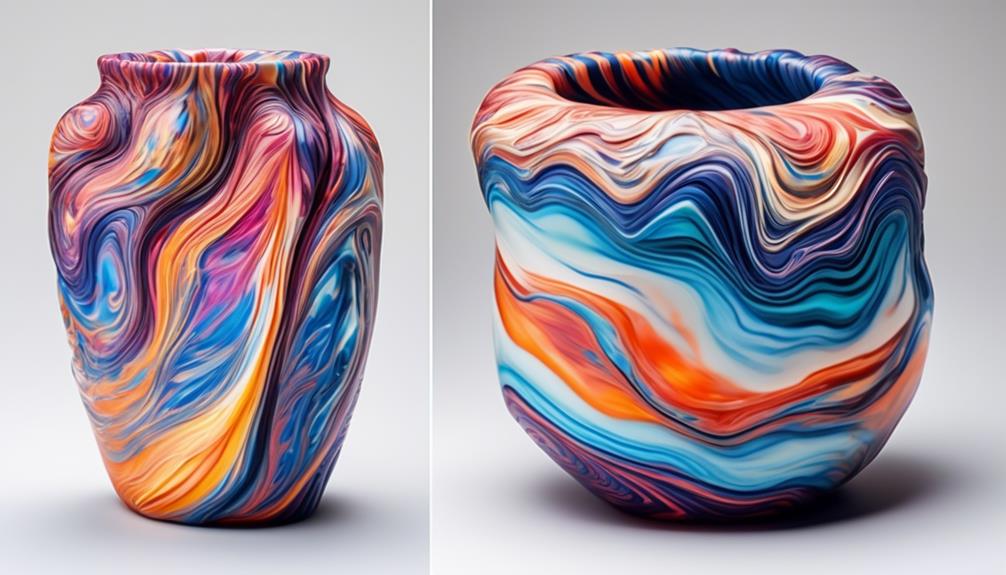
Using polymer clay and resin allows us to create intricate and durable vases with endless design possibilities. When working with these materials, we can let our creativity soar and craft stunning vases that stand out. Here's how we can make the most of polymer clay and resin for our vase-making endeavors:
- Creating unique designs: With polymer clay, we can mold and shape it into any form imaginable, from sleek and modern to ornate and detailed designs, making each vase one-of-a-kind.
- Experimenting with colors: Polymer clay comes in a wide array of vibrant colors, allowing us to mix and match and create custom hues for our vases. This opens the door to endless color combinations and possibilities.
- Textures and patterns: By experimenting with textures and patterns, we can add depth and visual interest to our vases. Whether it's a smooth, glossy finish or a textured, matte surface, the options are limitless.
- Durability and longevity: Resin provides a protective and glossy finish, ensuring that our vases not only look stunning but also withstand the test of time, making them a lasting addition to any space.
Working with polymer clay and resin empowers us to infuse our vases with personality, charm, and durability, making them truly exceptional pieces of art.
Unconventional Objects
As we delve into the realm of unconventional objects, we discover new opportunities to transform everyday items into extraordinary works of art through innovative techniques and imaginative design. Household items such as old teapots, vintage colanders, or even discarded light bulbs can be repurposed into stunning vases with a touch of creativity. By envisioning unconventional art, we can breathe new life into these forgotten objects.
Repurposed materials offer endless possibilities for creating unique vases. For instance, a discarded wine bottle can be transformed into a striking vase by simply cutting off the top and sanding the edges. The result is a sleek and modern vase that adds a touch of elegance to any space. Creative designs can also emerge from combining unexpected materials, such as using old vinyl records to craft a one-of-a-kind vase with a retro vibe.
Exploring unconventional objects allows us to unleash our artistic flair and reimagine the potential of everyday items. It's about finding beauty in the unexpected and creating something truly special from the ordinary.
Frequently Asked Questions
Can I Use a 3D Printer to Make a Vase?
Yes, a 3D printer can craft a vase beautifully.
With 3D printing, we can explore intricate vase designs, unique shapes, and custom sizes.
It's an exciting way to bring artistic ideas to life, whether it's a modern, minimalist design or something more elaborate.
The process allows for creative freedom and precision, making it an ideal choice for crafting a personalized vase that reflects our style and vision.
Is It Possible to Make a Vase Out of Fabric or Textiles?
Creating a fabric vase or a textile vase is an exciting and innovative way to add a touch of artistry to your space.
The versatility of fabric allows for endless possibilities in terms of patterns, textures, and colors, making it an ideal medium for crafting unique and personalized vases.
Can I Create a Vase Using Papier-Mâché?
Absolutely! We've had fun using papier mâché techniques to craft unique vases. It's a versatile method, and once the base is set, there are endless vase decorating ideas to explore.
The lightweight nature of papier mâché allows for intricate designs and shapes. Plus, it's a great way to upcycle old materials.
Get creative with paints, decoupage, or even mixed media to make each vase truly one-of-a-kind.
Are There Any Unconventional Items, Like Old Toys or Kitchen Utensils, That Can Be Used to Make a Vase?
Sure, there are some unconventional items that can be used to make a vase. Toy vases offer a playful and creative twist, while utensil art can give your vase a unique and functional look.
Try repurposing old toys or kitchen utensils to create a one-of-a-kind vase that reflects your personality and style. Get creative and experiment with different materials to craft a vase that stands out.
Can I Make a Vase Out of Edible Materials, Like Chocolate or Sugar?
Absolutely, we can make a chocolate vase! It's a delightful way to combine art and dessert.
For a sugar vase, we can use sugar paste to create intricate designs. These edible vases can be perfect for special occasions or as unique gifts.
With a little creativity and patience, creating these sweet masterpieces will be a rewarding and enjoyable experience.
Can I Use Edible Sprinkles to Decorate a DIY Vase?
Yes, you can use colorful edible sprinkle options to decorate a DIY vase. Simply apply a layer of glue to the vase, then sprinkle the edible decorations over the glue. Let it dry completely before handling. The result will be a unique and eye-catching vase that adds a fun and whimsical touch to your décor.
Conclusion
In conclusion, there are countless options for making a vase, from glass and ceramics to recycled items and unconventional objects. Just like a chef creates a masterpiece with various ingredients, we can craft a beautiful vase using different materials.
So, let your creativity flow and explore the possibilities to make a unique vase that reflects your style and personality. The world is your oyster, so go ahead and create a vase that speaks to your soul.
- About the Author
- Latest Posts
Introducing Ron, the home decor aficionado at ByRetreat, whose passion for creating beautiful and inviting spaces is at the heart of his work. With his deep knowledge of home decor and his innate sense of style, Ron brings a wealth of expertise and a keen eye for detail to the ByRetreat team.
Ron’s love for home decor goes beyond aesthetics; he understands that our surroundings play a significant role in our overall well-being and productivity. With this in mind, Ron is dedicated to transforming remote workspaces into havens of comfort, functionality, and beauty.
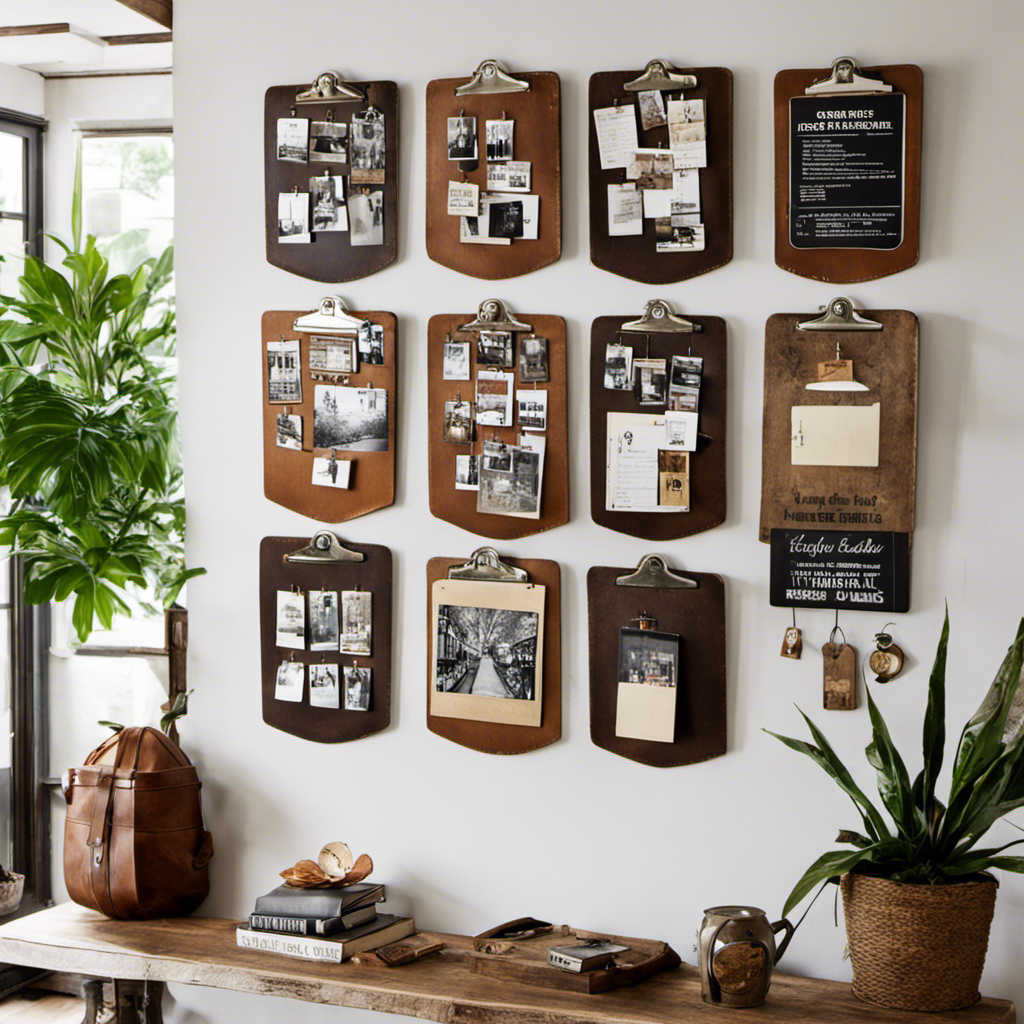
Did you realize that incorporating clipboards into your wall decorations can instantly enhance the style of any room? Translated in US English: Did you realize that incorporating clipboards into your wall decorations can instantly enhance the style of any room?
With their practicality and versatility, clipboards offer a unique and trendy way to display art, photos, or notes.
In this article, we will explore different ways to hang clipboards, providing you with creative DIY solutions and tips for styling them in your home.
Get ready to transform your walls into a personalized gallery that is both functional and visually stunning.
Key Takeaways
- Hanging clipboards as wall decor instantly elevates the style of any room.
- Select appropriate hanging hardware for secure installation and consider the overall theme and aesthetic of your home decor.
- Consider using adhesive hooks or picture hanging strips for easy installation and removal.
- Explore various ways clipboards can enhance your home decor or organizational system, such as incorporating them into office organization or using them as menu displays in restaurants.
Different Ways to Hang Clipboards as Wall Decor
You can use adhesive hooks or command strips to easily hang clipboards as wall decor. Incorporating clipboards in office organization isn’t only functional but can also add a touch of creativity to your workspace.
By hanging clipboards on the wall, you can keep important documents, to-do lists, and reminders easily accessible while also creating an aesthetically pleasing display. Additionally, clipboards can be used as photo displays, allowing you to showcase your favorite memories or inspiring images.
Simply attach photos to the clipboard using clips or magnets, and hang them on the wall. This not only adds a personal touch to your space but also allows you to easily change and update the photos whenever you want.
Choosing the Right Hanging Hardware for Clipboards
To properly display clipboards as decor, it’s important to select the appropriate hanging hardware. Proper installation techniques for hanging clipboards securely ensure that they stay in place and add a stylish touch to your home.
When choosing the right style of clipboards for your home decor, consider the overall theme and aesthetic you want to achieve. Whether you prefer a rustic, vintage look or a modern, sleek design, there are clipboards available to suit every taste.
Once you’ve selected the perfect clipboards, it’s time to choose the right hanging hardware. Look for hardware that’s durable, easy to install, and can support the weight of the clipboard. Options such as adhesive hooks, picture hanging strips, or wall-mounted hooks are ideal for hanging clipboards securely.
Remember to follow the manufacturer’s instructions for installation and use caution when handling any tools or hardware. With the proper hanging hardware and installation techniques, your clipboards will be securely displayed as stylish decor in no time.
DIY Hanging Solutions for Clipboards
When creating DIY hanging solutions for clipboards, consider using adhesive hooks or picture hanging strips for a secure and hassle-free display. These options provide a strong grip while also being easy to install and remove, making them perfect for repurposing clipboards into decorative pieces.
Adhesive hooks are versatile and can be attached to any smooth surface, such as walls or cabinets. They come in various sizes and weight capacities, ensuring that your clipboard stays securely in place.
Picture hanging strips are another great option, as they can hold heavier clipboards and provide a flush, seamless look. Simply apply the strips to the back of your clipboard and press firmly against the wall.
With these DIY hanging solutions, you can showcase your diy clipboard crafts with confidence and style.
Creative Display Ideas for Hanging Clipboards
Get creative with how you arrange and showcase your clipboards on the wall, using different sizes and orientations to create an eye-catching display.
Clipboards can be more than just functional office supplies; they can also be unique pieces of art that add personality to your home decor. Consider creating a visually appealing arrangement by combining clipboards of various sizes and orientations.
Picture this: a three-column, three-row table showcasing different clipboard styles. In the first column, you’ve a large vertical clipboard with a vibrant abstract painting. In the second column, a medium-sized horizontal clipboard displays a collection of vintage postcards. Finally, in the third column, a small square clipboard holds a mini gallery of your favorite photographs.
These unique clipboard wall displays not only serve as functional art but also allow you to easily switch out and update the contents whenever you desire.
Now, let’s explore some tips for styling clipboards in home decor.
Tips for Styling Clipboards in Home Decor
Arrange clipboards of different sizes and orientations in a visually appealing manner to create a unique and dynamic display in your home. Hang them on the wall to keep important documents within reach while adding an interesting visual element.
Incorporating clipboards into office organization adds a touch of creativity and functionality. Use larger clipboards to hold to-do lists, calendar reminders, or even inspirational quotes. Smaller clipboards can be used to display photos, notes, or memos.
Clipboards can also be repurposed as menu displays in restaurants. Attach the menu to the clipboard and hang it near the entrance or at each table. This allows for easy changes and updates to the menu, as well as adding a charming and rustic touch to the overall restaurant decor.
Get creative and explore the various ways clipboards can enhance your home decor or organizational system.
Frequently Asked Questions
Where Can I Purchase Clipboards for Wall Decor?
You can find clipboards for wall decor at various places like office supply stores, craft stores, or online retailers. They can be used creatively in home decor, and there are many DIY clipboard display ideas for wall decor.
Can Clipboards Be Hung Horizontally as Well as Vertically?
Sure! Clipboards can be hung both horizontally and vertically. This gives you endless creative possibilities for decorating with clipboards. You can display photos, artwork, to-do lists, or even a menu! Get ready to transform your space with a clipboard extravaganza!
Are There Any Specific Types of Clipboards That Work Best for Hanging as Wall Decor?
For creative ways to use clipboards as wall decor, consider DIY ideas like painting or adding fabric to customize them. Look for clipboards with sturdy hanging hooks or attach your own for easy display.
Can Clipboards Be Easily Removed From the Wall Without Causing Damage?
Removing clipboards without damage is as easy as peeling a sticker off a window. Gently lift and wiggle the clipboard to release it from the wall. Alternatively, use adhesive hooks for hassle-free hanging.
Are There Any Special Considerations for Hanging Clipboards in High Humidity Areas, Such as Bathrooms?
In high humidity areas like bathrooms, consider using alternative ways to decorate with clipboards. Try hanging clipboard alternatives like magnetic boards or adhesive hooks to display important papers without worrying about damage.
Can I Use a Clipboard to Decorate My Space?
Introducing your home decor a stylish clipboard can be a versatile and functional way to add a personal touch to any space. Whether you use it to display photos, artwork, or inspirational quotes, a well-decorated clipboard can be a unique and eye-catching addition to your home or office.
Conclusion
As you hang your clipboards as wall decor, you’ll discover a world of creativity and organization at your fingertips. The coincidental blend of functionality and aesthetics will bring a unique charm to any space.
So go ahead, choose the perfect hanging hardware, experiment with DIY solutions, and let your imagination soar as you find creative ways to display and style your clipboards.
Transform your home decor with this simple yet captivating addition.
- About the Author
- Latest Posts
Introducing Ron, the home decor aficionado at ByRetreat, whose passion for creating beautiful and inviting spaces is at the heart of his work. With his deep knowledge of home decor and his innate sense of style, Ron brings a wealth of expertise and a keen eye for detail to the ByRetreat team.
Ron’s love for home decor goes beyond aesthetics; he understands that our surroundings play a significant role in our overall well-being and productivity. With this in mind, Ron is dedicated to transforming remote workspaces into havens of comfort, functionality, and beauty.
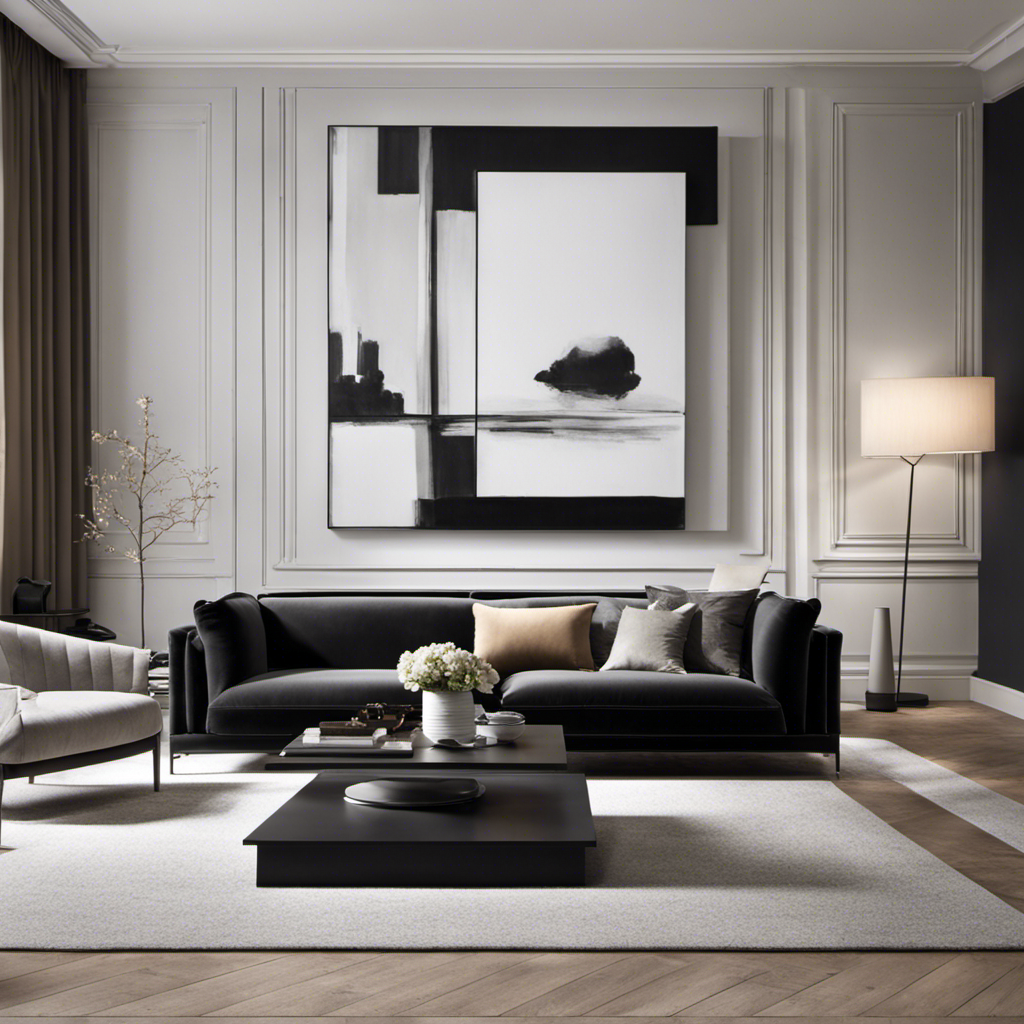
Are you feeling bored with plain walls that lack flair and character? You’ve come to the right place! In this article, we’ll show you how to turn your bare walls into beautiful pieces of art.
Discover the secrets of choosing the perfect wall decor, utilizing shelves and display units, creating captivating gallery walls, incorporating mirrors for added depth, and adding texture with wall hangings and tapestries.
Get ready to turn your bare walls into a visual masterpiece!
Key Takeaways
- Consider the size and style of your space
- Wall murals can transform a plain wall
- Framed artwork adds elegance
- Select pieces that reflect your personal style and interests
Choosing the Right Wall Decor
You should start by considering the size and style of your space when choosing the right wall decor. Whether you want to add a touch of whimsy or create a sophisticated atmosphere, there are endless possibilities to explore.
One option is a wall mural, which can transform a plain wall into a stunning focal point. Choose a design that complements your existing furniture and color scheme, and watch as your space comes to life.
Another option is framed artwork, which adds a touch of elegance to any room. Select pieces that reflect your personal style and interests, and arrange them in a way that creates visual interest.
Utilizing Wall Shelves and Display Units
Make the most of your space by utilizing wall shelves and display units. These stylish storage solutions not only help you declutter your living area but also provide a functional display for your favorite items.
Here’s why you should consider incorporating wall shelves and display units into your home decor:
-
Showcase your personality: Display your unique collection of books, artwork, or sentimental objects to add a personal touch to your space.
-
Maximize small spaces: Wall shelves and display units are perfect for small rooms where floor space is limited. They allow you to utilize vertical space effectively.
-
Create a focal point: Arrange your items creatively on the shelves to create a stunning focal point that catches the eye of anyone entering the room.
By incorporating wall shelves and display units, you can create a stylish storage solution that adds both functionality and aesthetic appeal to your home.
Now, let’s explore how to take your wall decor to the next level by creating a gallery wall.
Creating a Gallery Wall
To create a visually captivating gallery wall, arrange a variety of framed artwork and photographs in different sizes and orientations. Start by selecting artwork that resonates with you and complements the overall aesthetic of your space. Consider themes, colors, and styles that will tie everything together.
Mix and match frames to add visual interest and dimension. Opt for different materials and finishes, such as wood, metal, or acrylic, to create contrast. Play with the arrangement by placing larger pieces in the center and gradually filling in the surrounding space with smaller pieces. Experiment with different layouts by laying out the frames on the floor before hanging them.
Once you’ve achieved the desired composition, start hanging your artwork, making sure to space them evenly and at eye level. By carefully arranging artwork and selecting frames that enhance their beauty, you can create a gallery wall that’s both visually stunning and meaningful.
Now, let’s explore how incorporating mirrors and reflective surfaces can further enhance your wall decor.
Incorporating Mirrors and Reflective Surfaces
Start by choosing mirrors and reflective surfaces that complement the overall aesthetic of your space, adding depth and dimension to your gallery wall. Mirrors are a versatile choice that not only reflect light, but also create the illusion of a larger space. Reflective surfaces, such as metallic accents, can add a touch of glamour and sophistication to your wall decor.
To evoke an emotional response in the audience, consider the following:
- Maximizing natural light: Mirrors and reflective surfaces can help bounce natural light around the room, creating a bright and airy atmosphere that uplifts the mood.
- Creating a sense of luxury: Metallic accents, like gold or silver-framed mirrors, can bring a touch of opulence and elegance to your gallery wall, making it feel like a luxurious retreat.
- Adding depth and intrigue: By strategically placing mirrors and reflective surfaces, you can create visual interest and play with perspective, drawing the viewer’s eye and sparking curiosity.
Incorporating mirrors and reflective surfaces into your gallery wall not only enhances the overall aesthetic, but also adds a touch of magic and allure to your space.
Adding Texture With Wall Hangings and Tapestries
Enhance the visual appeal of your gallery space by incorporating textured wall hangings and tapestries that add depth and interest to your overall design.
Using macrame wall hangings and exploring different types of tapestries can bring a unique touch to your empty walls. Macrame wall hangings are made by knotting various threads together, creating intricate patterns and textures. They’re versatile and can be hung in various sizes and shapes, depending on your preference.
On the other hand, tapestries offer a wide range of options, from traditional to modern designs. You can choose from vibrant colors, intricate patterns, or even opt for a more minimalistic approach. Tapestries add visual interest and a sense of warmth to any space.
Frequently Asked Questions
How Can I Ensure My Wall Decor Matches the Overall Theme of My Room?
To ensure your wall decor matches your room’s overall theme, consider incorporating plants. The natural elements will bring harmony and balance to the space. Choose decor pieces that complement the colors and style of your room for a cohesive look.
What Are Some Creative Ways to Incorporate Plants Into My Wall Decor?
To incorporate plants into your wall decor, try using hanging planters for a unique touch. You can also explore vertical garden ideas to create a stunning display that adds life and vibrancy to your space.
Can You Provide Tips on How to Arrange Different Sized Frames and Artworks on a Gallery Wall?
Arrange frames and artworks on a gallery wall like a symphony conductor, blending different frame styles harmoniously. Play with sizes, textures, and themes. Let your creativity guide you as you curate a visually captivating wall display.
What Are Some Unique Ways to Use Mirrors in Wall Decor, Other Than Just Hanging Them on the Wall?
To make a statement with mirrors, consider using them as unique and eye-catching pieces in your wall decor. Think beyond hanging them and try incorporating mirrors into furniture for a stylish and unexpected touch.
Are There Any Specific Wall Hanging or Tapestry Materials That Work Best for Different Types of Rooms or Decor Styles?
For outdoor spaces, consider using wall hanging materials like weather-resistant fabrics or metal. When choosing tapestry colors for a vibrant decor style, opt for bold and bright hues that will make a statement in your space.
How Can I Incorporate Decor to Fill Up Empty Tan Walls?
Decorating tan walls can be a bit tricky, but there are ways to fill up the empty space. Add some colorful wall art or mirrors to create visual interest. Consider incorporating shelves to display unique decor pieces. Don’t be afraid to mix and match textures and patterns to bring life to your decor with tan walls.
Conclusion
In conclusion, decorating an empty wall is like adding the final brushstroke to a masterpiece. It’s an opportunity to showcase your personal style and bring life to a blank canvas.
Whether you choose to hang shelves, create a gallery wall, incorporate mirrors, or add texture with wall hangings, each option adds depth and character to your space.
So go ahead, unleash your creativity and transform that empty wall into a captivating work of art.
- About the Author
- Latest Posts
Meet Katherine, the creative enthusiast at ByRetreat who infuses her boundless passion for design into every remote workspace she crafts. With an innate sense of creativity and an eye for unconventional beauty, Katherine brings a unique and inspiring perspective to the team.
Katherine’s love for design is infectious, and her ability to think outside the box sets her apart. She believes that true artistry lies in embracing a variety of styles and mixing them harmoniously to create captivating spaces. By combining different textures, colors, and patterns, Katherine weaves a tapestry of creativity that breathes life into each remote workspace.
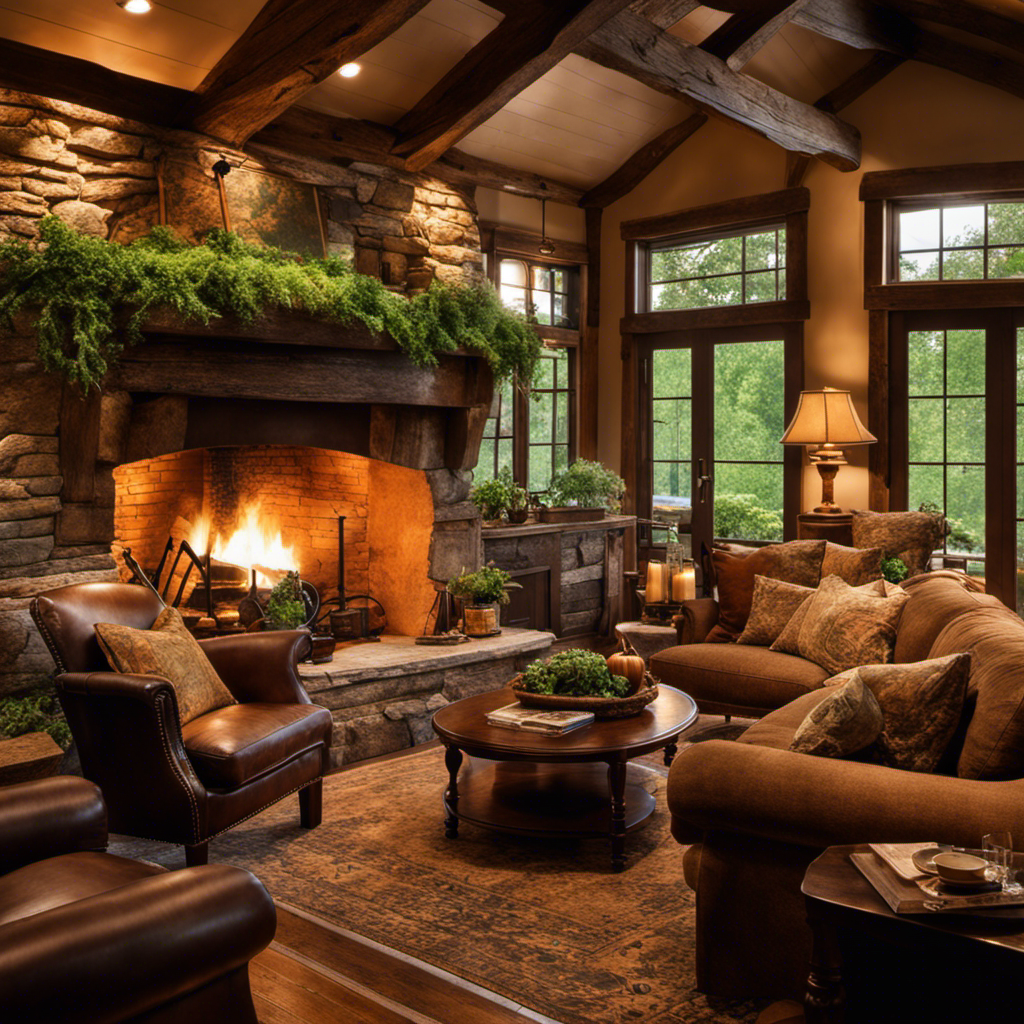
Picture entering a home that exudes a cozy sanctuary vibe, brimming with charm and whimsy. Envision being enveloped by rich hues, welcoming textures, and organic materials that add a hint of enchantment to every nook and cranny.
This is the essence of home decor like Baggen, inspired by the enchanting world of Hobbits. In this article, we will guide you on how to recreate the magic of Baggen in your own home, from choosing the right color palette to adding quirky and whimsical touches.
Get ready to transform your space into a haven of comfort and charm.
Key Takeaways
- Choose a color palette that reflects the cozy and earthy vibe of Bag End, incorporating warm base colors and pops of bold colors for contrast.
- Layer fabrics with different textures and mix and match patterns to create visual interest in your decor.
- Embrace natural elements like wood, stone, and plants to create a space that feels connected to the earth.
- Add quirky and whimsical touches through DIY projects, unique furniture pieces, and vibrant accent pieces to bring character to your space.
Choosing the Right Color Palette
You should start by selecting a color palette that reflects the cozy and earthy vibe of Bag End. To create a minimalist look inspired by the iconic home of Bilbo Baggins, consider exploring bold and vibrant colors.
Begin by choosing a base color that evokes a sense of warmth and comfort, such as a rich earth tone like deep brown or warm beige. This will serve as the foundation for your color scheme.
Next, add pops of bold colors like forest green or deep red to create visual interest and contrast. These bold hues will bring life and energy to your space, while still maintaining a cozy and earthy atmosphere.
Lastly, incorporate natural textures and materials like wood, stone, and woven textiles to enhance the overall cozy and organic aesthetic.
Incorporating Cozy Textures
To create a cozy atmosphere in your space, try incorporating soft textures like plush blankets and velvety cushions. These elements not only add visual appeal but also provide a tactile experience that invites you to relax and unwind. Here are some tips to help you incorporate cozy textures into your home decor:
-
Layering fabrics: Mix and match different textures by layering throw blankets and pillows of varying materials, such as faux fur, knits, and velvet. This adds depth and warmth to your space.
-
Mixing patterns: Don’t be afraid to mix and match patterns to create visual interest. Pairing a bold geometric pattern with a subtle floral print can create a harmonious balance in your decor.
-
Adding textured rugs: Incorporate rugs with plush textures like shag or sheepskin to add a soft and luxurious feel to your floors.
-
Using curtains and drapes: Opt for curtains or drapes made from thick, heavy fabrics like velvet or brocade. This not only adds privacy but also enhances the cozy ambiance of your space.
By incorporating these cozy textures, you’ll create a warm and inviting atmosphere in your home, perfect for curling up with a good book or enjoying a cup of tea.
In addition to cozy textures, embracing natural elements can further enhance the overall ambiance of your space.
Embracing Natural Elements
Embrace the beauty of nature by incorporating natural elements into your space, such as wooden furniture, potted plants, and stone accents. By using plants in your home decor, you can bring a sense of tranquility and freshness to any room. Not only do plants add visual appeal, but they also purify the air and create a calming atmosphere. When it comes to furniture and accessories, utilizing natural materials like wood and stone can enhance the overall aesthetic and create a warm and inviting ambiance. Imagine sitting on a comfortable wooden chair surrounded by lush greenery, with a stone accent table holding a cup of tea. It’s a perfect blend of nature and comfort, creating a space that feels connected to the earth.
| Wooden Furniture | Potted Plants | Stone Accents |
|---|---|---|
| Oak Dining Table | Fiddle Leaf Fig Tree | Marble Coasters |
| Teak Bookshelf | Snake Plant | Granite Vase |
| Walnut Coffee Table | Succulent Arrangement | Slate Candle Holder |
| Birch Nightstand | Monstera Deliciosa | Limestone Wall Art |
Incorporating these natural elements into your home decor not only adds visual interest but also brings a sense of harmony and serenity. So go ahead, embrace the beauty of nature and create a space that feels like a peaceful oasis.
Adding Quirky and Whimsical Touches
Let your space come alive with quirky and whimsical touches, adding a playful and unique charm to your home. Transform your living space into a whimsical wonderland by incorporating DIY projects and unique furniture pieces.
Here’s how you can achieve it:
-
DIY projects: Get creative and craft unique decor pieces like painted mason jars, hand-painted throw pillows, or a custom-made wall mural. These DIY projects will add a personal touch to your home and showcase your artistic side.
-
Unique furniture pieces: Look for one-of-a-kind furniture pieces that bring character to your space. Think vintage-inspired chairs, a funky coffee table, or a statement bookshelf. These unique furniture pieces will instantly become conversation starters and give your home a distinct personality.
-
Colorful accents: Add pops of color with vibrant accent pieces like bright rugs, colorful artwork, or funky lampshades. These playful accents will inject energy and liveliness into your space.
-
Whimsical details: Don’t forget the smaller details! Incorporate whimsical touches like fairy lights, quirky wall decals, or whimsical wallpaper to create a magical atmosphere in your home.
With these quirky and whimsical additions, your home will become a haven of creativity and imagination. Let your personality shine through and enjoy the delightful charm of your newly transformed space.
Creating Functional and Organized Spaces
Organize your space efficiently by utilizing storage solutions that maximize functionality and keep your belongings easily accessible.
When it comes to maximizing small spaces, incorporating multi-functional furniture is key. Think of pieces that can serve multiple purposes, such as a coffee table with hidden storage compartments, or a sofa that can be converted into a guest bed. These clever furniture options not only save space but also add versatility to your home decor.
Consider wall-mounted shelves or floating cabinets to make use of vertical space, freeing up floor area. Don’t forget about the power of organization. Invest in bins, baskets, and drawer dividers to keep everything in its place.
Frequently Asked Questions
What Are Some Tips for Finding Unique and Eccentric Home Decor Pieces to Add a Touch of Quirkiness to My Space?
Looking to add some quirkiness to your space? Try these tips for thrift shopping and DIY home decor projects. Find unique and eccentric pieces that will make your home feel like Baggend.
How Can I Create a Functional and Organized Space Without Compromising on Style?
To create a functional and stylish workspace, maximize storage in a small living space. Utilize vertical shelving, multipurpose furniture, and clever organization systems. Remember, a place for everything and everything in its place.
Are There Any Specific Natural Elements That Work Particularly Well in Creating a Baggend-Inspired Home Decor?
To create a Baggend-inspired home decor, incorporate specific natural materials like wood and stone. DIY projects such as making your own rustic furniture or creating a cozy fireplace can further enhance the whimsical charm of your space.
Can You Suggest Some Ways to Incorporate Cozy Textures Into My Home Decor Without Making It Look Cluttered?
To incorporate cozy textures into your home decor without clutter, try adding soft throw blankets and plush pillows. Opt for natural materials like wool and velvet for a warm and inviting feel.
What Are Some Common Mistakes to Avoid When Choosing a Color Palette for a Baggend-Inspired Home Decor?
When choosing a color palette for a Baggend-inspired home decor, common mistakes to avoid include using too many vibrant colors or neglecting to create a sense of warmth. The best color combinations are earthy tones with pops of rich, jewel-like hues.
Can Primitive Salt Box Decor Be Incorporated into a Baggend-themed Home Decor?
Yes, building primitive salt box decor can be seamlessly incorporated into a Baggend-themed home decor. The rustic and earthy elements of primitive salt box decor perfectly complement the cozy and whimsical feel of a Baggend-inspired home. Add some handmade wooden pieces and earth-toned textiles to complete the look.
Conclusion
So, there you’ve it – your guide to creating a home decor that would make even a hobbit feel right at home!
By choosing the right color palette, incorporating cozy textures, embracing natural elements, adding quirky touches, and creating functional spaces, you can transform your space into a Bagend-inspired haven.
So go ahead, embrace your inner hobbit and let your creativity run wild. Your home will be the envy of all Middle-earth!
- About the Author
- Latest Posts
Meet Katherine, the creative enthusiast at ByRetreat who infuses her boundless passion for design into every remote workspace she crafts. With an innate sense of creativity and an eye for unconventional beauty, Katherine brings a unique and inspiring perspective to the team.
Katherine’s love for design is infectious, and her ability to think outside the box sets her apart. She believes that true artistry lies in embracing a variety of styles and mixing them harmoniously to create captivating spaces. By combining different textures, colors, and patterns, Katherine weaves a tapestry of creativity that breathes life into each remote workspace.
-
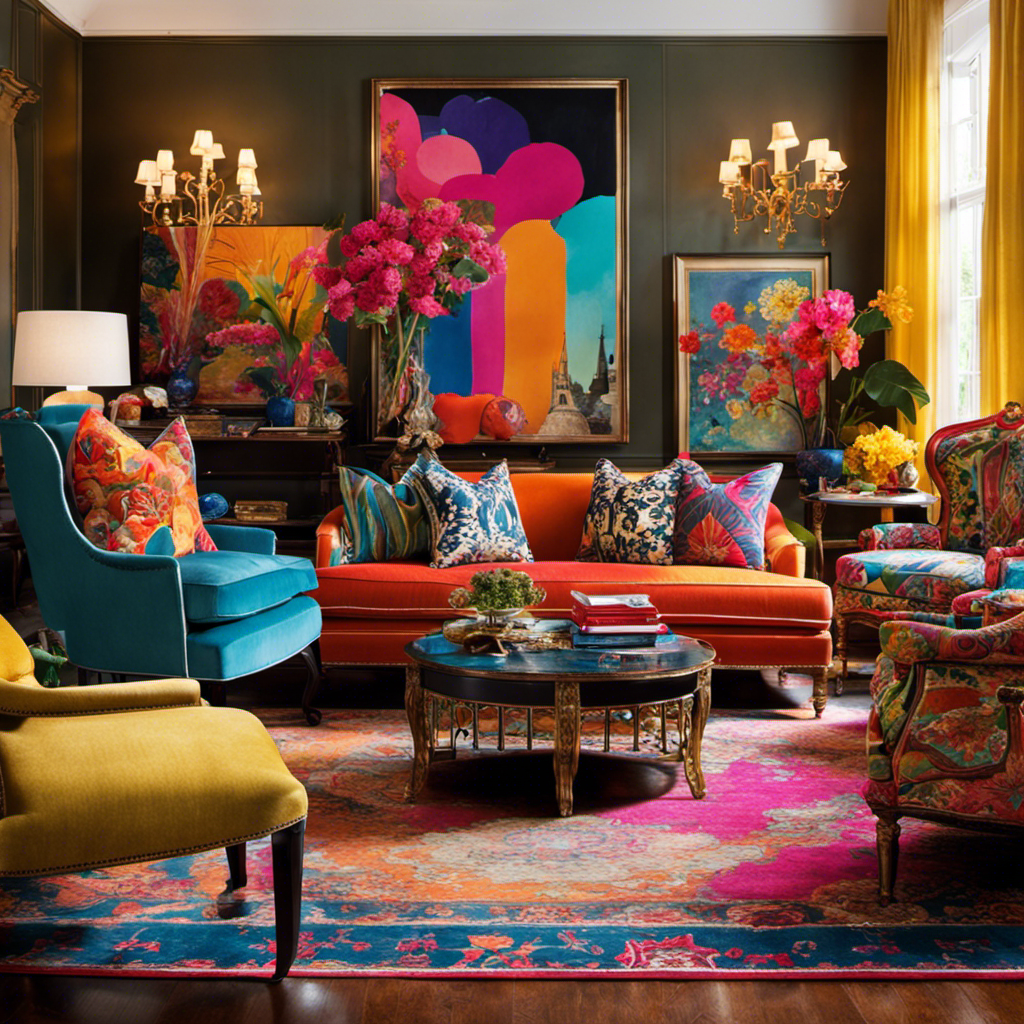
 Decor2 weeks ago
Decor2 weeks agoMaximalist Decor Explained: Embrace More Style
-

 Vetted2 weeks ago
Vetted2 weeks ago15 Best Foot Massagers for Neuropathy to Soothe Your Feet and Relieve Discomfort
-

 Vetted3 weeks ago
Vetted3 weeks ago15 Best Sports Laundry Detergents for Keeping Your Activewear Fresh and Clean
-
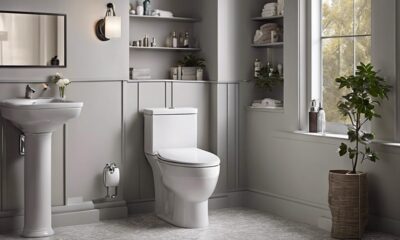
 Vetted3 weeks ago
Vetted3 weeks ago15 Best Tall Toilets for Seniors That Combine Comfort and Safety
-

 Vetted4 weeks ago
Vetted4 weeks ago15 Best Dish Scrubbers to Keep Your Kitchen Sparkling Clean
-
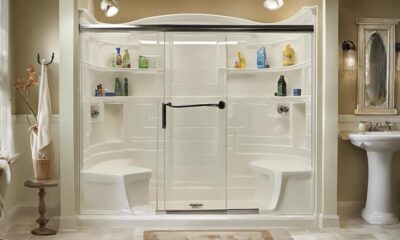
 Vetted3 days ago
Vetted3 days ago15 Best Cleaners for Fiberglass Showers to Keep Your Bathroom Sparkling Clean
-
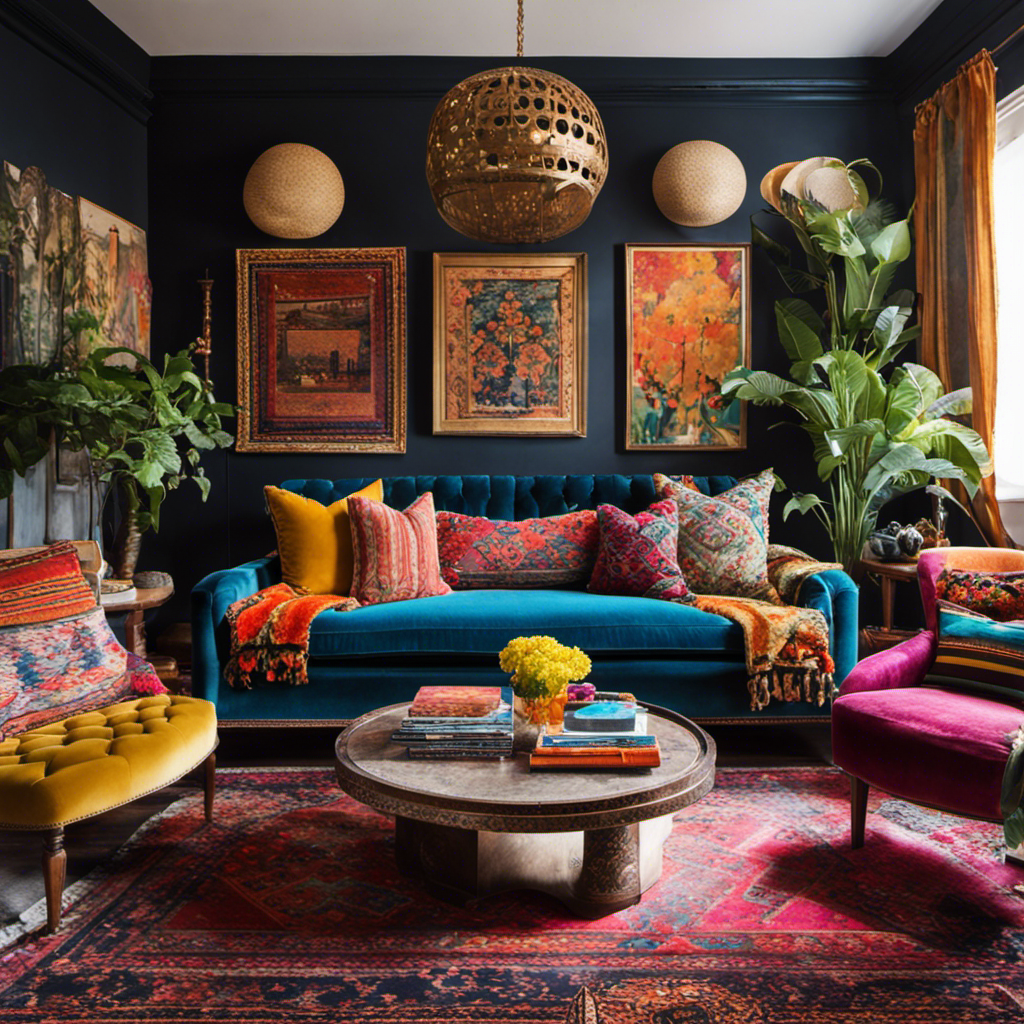
 Decor4 weeks ago
Decor4 weeks agoWhat Is Eclectic Home Decor
-

 Vetted1 week ago
Vetted1 week ago15 Best Organic Pest Control Solutions for a Naturally Pest-Free Home









